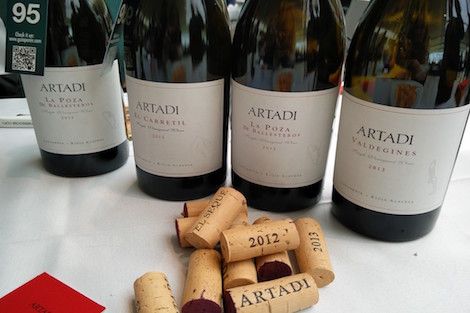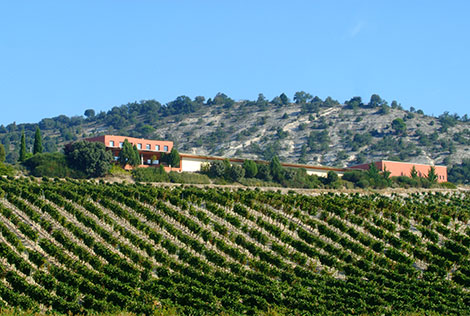
The announcement by Juan Carlos López de Lacalle (Artadi) of his departure from the DOCa Rioja is arguably the biggest setback for Spain’s denomination of origin system. This rescuer of old vines and singular plots in Rioja Alavesa, such as legendary Viña El Pisón, is not the first to make this move. Others, such as Gutiérrez de la Vega in Alicante and Raventós i Blanc in Cava, have quit their respective DOs. But Artadi’s departure questions the effectiveness of Spain’s most prestigious appellation to create tools that ensure the singularity of its vineyards and terroir.
Rioja is on the spotlight, but there are signs that Spain’s DO umbrella protection is no longer enough to many of those underneath it. This past week alone, two meetings have been held to discuss Spain’s vineyards and the need to come up with an organization and classification system to ensure the singularity of terroir wines beyond the generic label provided by a regional DO.
These two gatherings happened days before the birth of Rioja ’n’ Roll, a grouping of eight Rioja winegrowers who are making a name for themselves such as Roberto Oliván (Tentenublo), Olivier Rivière, Tom Puyaubert (Exopto) or Artuke, among others. Their aim, they say, is “to defend wines made by actual people; wines made in specific villages and vineyards; wines that are free and are not boxed into a category, wines which reflect our personality and the vineyards that we work in Rioja.”
A forum to discuss Spanish vineyards
“All I want after 35 years of work is to be able to work comfortably”, said Juan Carlos López de Lacalle at a round table held at Madrid’s Club Matador under the title Thoughts about Spain’s great vineyards. Artadi’s founder claims to be alone in his demands because the others fail to see a business future for terroir wines. López de Lacalle is also convinced that “the process of showcasing Spain’s small wine growing practices is unstoppable”. He remembers his five years as member of the Regulatory Body management team and his contribution to the rules set up in 1990. Back then, he tried to convince his colleagues that “it was a historical moment to divide Rioja into separate zones” but his proposal failed to find support.
The Club Matador event was organized by leading Rioja producer Telmo Rodríguez (Cía de Vinos Telmo Rodríguez, Remelluri), who acted as moderator in a debate with the participation of producers (Daniel Landi from Comando G in Gredos, Pepe Raventós from Raventós i Blanc), critics and journalists (Luis Gutiérrez, Spain’s taster for The Wine Advocate along with Víctor de la Serna, José Peñín and Amaya Cervera from Spanish Wine Lover), distributors and wine traders (Paco Berciano, Joan Valencia, Juan Manuel Bellver) or art expert Vicente Todolí. The only Regulatory Body in the house was Priorat’s, represented by president Salustià Álvarez. The Catalan region is the only Spanish appellation to have established a territorial division with the creation of vi de la vila (village wines) and vi de finca (estate wines).
A majority of participants agreed that it is urgent and necessary to set up a classification along the lines of the most prestigious French regions, with village wines, estate wines and single vineyard wines.
Spanish wines are seen as cheap, which is worrying. The average price of Spanish wine by August 2015 was €1.02, the lowest in export countries, according to data published by the OEMV (Spanish Wine Market Watchdog Foundation). It is mandatory “to bring some dignity onto Spanish wine and boost our wine heritage”, insisted Gredos winegrower Daniel G. Landi. “The more specific our wines are, the more international they will be”.
For Pepe Raventós, from Raventós i Blanc, “the future lies not on competing against emerging markets and the New World but to follow the French model” and favours working with local varieties, yield reduction, and increase of minimum grape prices and the need to sell wines with vintage indication.
With or without the regulatory bodies
“People love to set themselves apart in terms of the wines they drink”, reckoned Catalán distributor Joan Valencia who warned that “any classification must come after a thorough study of soils”. Peter Sisseck, the Dane behind Pingus, who was in the audience, confirmed that Ribera del Duero has set up an investigation commission as a first step to determine soil qualities in the area. In a second stage, various yields and specific areas would be determined in terms of the style of the wines such grapes would be destined for, such as young and oak-aged wines or other wines with longer aging times. “High-yielding vineyards planted in inadequate locations cannot be removed just because we are landscape romantics”, stated Sisseck.
Wine critic and Manchuela producer Víctor de la Serna explained that Rioja brands are highly detached from their source vineyards and encouraged the DOCa Rioja, which has traditionally been a model for other wine regions in Spain, to set the wheels in motion towards a division of the land in terms of quality. “We need a system to identify zones and a quality seal that allows producers to include a specific origin on the label”.
Distributor and importer Paco Berciano (Alma Vinos) wondered if this initiative should be carried out “with” or “against regulatory bodies; they represent the reality of the business, which is focused on producers instead of vignerons; the more we restrain the space, the more expensive grapes will be”. Berciano argued in favour of a private model such as Germany’s VDP which includes around 200 wine producers.
Meanwhile Telmo Rodríguez said the change should be positive for everyone. “This is not about going against anyone; we shouldn’t forget that Romanée-Conti drives sales of cheap Burgundy wine”.
Priorat’s model
The DOQ Priorat is proof that wine regions can be subdivided in Spain. Its president, Salustià Álvarez, said “wine is the territory’s greatest ambassador” and praised the work done by winegrowers as an essential tool to achieve such recognition. “The region can survive with people who make a decent living with their small vineyard and who feels proud about it”.
Priorat’s land division model is based on the classic French pyramid: “country or table wines are at the bottom; a step above is reserved for wines with DO followed up by DOC wines, village wines, single vineyard wines and finally wines coming from singular plots”.
The average price per kilo of grapes in Priorat on the 2014 vintage was €1.6 and average bottle prices reached €20, the highest in Spain. Salustià Álvarez valued the fact that production is widely spread: “It’s much better to have 100 small wineries than two big brands”.
Rioja Alavesa picks up the debate
A great deal of the ideas heard at Club Matador were echoed in Rioja last Saturday during the conference Denomination of Origin - Identity and Differentiation organized by Juan Carlos López de Lacalle in Laguardia, the Rioja Alavesa town where his winery is located, reports Yolanda Ortiz de Arri.
Four of the members of the round table had also been present in Madrid —Artadi’s owner, Telmo Rodríguez, Dani Landi and Salustià Álvarez. They were joined by Gabriel Frías, president of ABRA (Association of Rioja Alavesa Wineries), who criticised “the sea of wine looming over us with the increase in yields and new plantings” recently approved by the DOCa Rioja, and professor and winegrower Pedro Balda, who deplored that despite the “outstanding vineyards and winegrowers in San Vicente de la Sonsierra, my village" —and thus, in the rest of Rioja— “I can count with the fingers in one hand the number of young people who have launched small personal projects”, he said in front of a room packed with local politicians and winegrowers.
Another high-profile speaker was Álvaro Palacios. The man behind Priorat’s L’Ermita and the resurgence of the family winery in Rioja Baja called for a pyramid of quality “because the top will seep through and will benefit everyone involved” as well as “freedom for producers to use subarea labels provided that grapes do indeed come from such region. That would be a first step —consumers are already familiar with this classification. The second step should be the recognition of village wines, an essential step before the creation of a single vineyard category. Later on it will be the turn of grand crus, although that will be something for our grandchildren or great-grandchildren to implement. But for this step to occur, we must start the work right now”.
A distinctive non-confrontational approach
The conference in Laguardia started with former Basque prime minister Juan José Ibarretxe, who listed identity, culture and education as essential elements in order for the region to have its own voice. “We need to look out to the world to see Rioja Alavesa wines, and I don’t see them. This region needs a distinctive, voluntary and non-confrontational project. Universal things are always a sum of local things”, Ibarretxe said. “The idea of a sub-DO should not be rejected, but instead of working towards building it, the project is fading away.”
This concept of homogeneity in Rioja was echoed by Miguel Larreina, a wine technician who has written several books about Rioja Alavesa. He alerted that “80% of Rioja wine is handled by 40 business groups, macro-wineries with interests in several DO; very powerful people”. Larreina explained that in the history of DOCa Rioja there have been many changes “in vines, yields, production areas, aging times, taxes and types of wine. Changes are possible, but energy and willingness to carry out such changes are vital.”
In a regulatory body controlled by groups, the opportunity for change is tiny, but as Law professor Josep M. Sabaté explained, DO changes are allowed with relative ease. “A differentiating element must be justified, but it is legally possible. France and Italy have created a considerable number of them.”
Rioja ’n’ Roll
In the midst of such demands for change and recognition of the region’s singularities springs Rioja ’n’ Roll, a maverick group of young growers and winemakers based on the three Rioja subzones who want to draw attention to a common work ethic based on the vineyard and a style of wines that goes beyond geographical or administrative rigidities.
“It is much more what unites us than divides us”, explain Roberto Oliván (Tentenublo Wines), Frenchmen Olivier Rivière (Olivier Rivière Vinos), Tom Puyaubert (Exopto), Arturo and Kike de Miguel (Artuke), Sandra Bravo (Sierra de Toloño), Bárbara Palacios (Barbarot), Óscar Alegre and Eva Valgañón (Alegre & Valgañón) and South African Bryan MacRobert (Laventura). They are aware of the tradition and recognition of the Rioja brand, but believe it is time to recognize the region’s heritage. “Rioja vineyards have tremendous potential, but it has often been neglected. We must defend wines with personality”.
Undoubtedly, there is an increasing number of people within Spain’s wine sector pulling in the same direction; it remains to be seen if the countries DOs will take steps to respond to the calls of many small but renowned winegrowers who demand differentiation and authenticity.
Participants at Club Matador’s round table were asked to write a short text to try and answer questions such as: Have our winegrowers and producers managed to tell us about these exceptional vineyards?, Has our Denomination of Origin system been able to define and preserve them?, Can our country generate an image of quality without taking such vineyards into account? The full document can be downloaded in Spanish here.

Amaya Cervera
A wine journalist with almost 30 years' experience, she is the founder of the award-winning Spanish Wine Lover website. In 2023, she won the National Gastronomy Award for Gastronomic Communication
NEWSLETTER
Join our community of Spanish wine lovers






